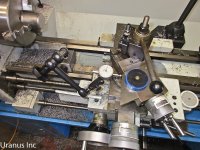jonwinchester
Plastic
- Joined
- Jul 22, 2016
Long story very short. 29.5° has been the compound angle I've used to cut threads for the past 20 years. The lathe I run currently, when threading at 29.5° cuts the back of the thread off. I ask one of the older guys how he threads and he tells me he sets his compound at 60° . Wtf. I try it and it works perfectly. I'm hoping someone can help me out to understand what's going on. Thanks! Oh, I run a Chinese made conventional lathe.



